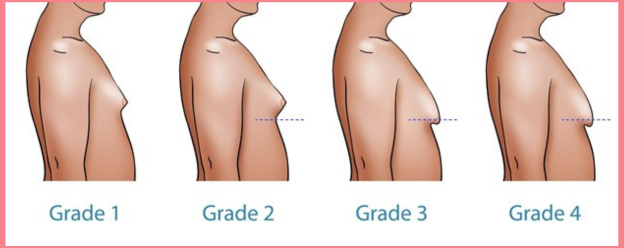Gynecomastia is a common condition that causes enlarged breast tissue in men, and it can affect men of all ages. Whether you’re a teenager experiencing changes during puberty or an adult man dealing with a hormonal imbalance, you might find yourself wondering about the stages of gynecomastia and what each stage means for your treatment options. One particular stage that often gets a lot of attention is Grade 3 gynecomastia. So, what exactly is Grade 3 gynecomastia, and how is it different from the other stages of the condition?
In this article, we will explain Grade 3 gynecomastia, how it differs from other stages, and what you can do about it. If you’re dealing with gynecomastia, it’s important to understand the stages of the condition so that you can determine the right treatment plan for your situation. Whether you’re in the early stages or dealing with Grade 3 gynecomastia, Dr. Anmol Chugh, an expert in gynecomastia surgery, is here to help guide you through the process and find the best solution for your needs.
What is Gynecomastia?
Before we dive into Grade 3 gynecomastia, it’s essential to understand what gynecomastia is. Gynecomastia is the enlargement of breast tissue in men. This condition occurs when there is an imbalance between the hormones testosterone and estrogen, which leads to the growth of excess breast tissue. Unlike pseudogynecomastia, which is the result of fat buildup in the chest, gynecomastia involves the growth of glandular tissue.
This condition is fairly common and can affect men at any age, though it is most often seen during puberty and in older men due to hormonal changes. However, gynecomastia can also be caused by medications, obesity, or other underlying medical conditions.
Understanding the Stages of Gynecomastia
Gynecomastia is often classified into four stages, each reflecting the severity and extent of the breast tissue enlargement. The stages are helpful in determining how gynecomastia is progressing and, in turn, the best approach to treatment. These stages range from mild to severe and are important in guiding treatment options, such as medication, lifestyle changes, or surgery.
The stages of gynecomastia are:

- Grade 1: This is the mildest form of gynecomastia, where there is a small enlargement of the breast tissue. It’s typically subtle and not very noticeable. The nipple area may appear a little puffier, but the enlargement is usually not very noticeable.
- Grade 2: In this stage, the breast tissue becomes more pronounced, and there is an obvious enlargement around the nipple. The area may start to look fuller, and the gynecomastia may become more visible, but there is still no significant sagging of the tissue.
- Grade 3: Grade 3 gynecomastia is more advanced. At this stage, the breast tissue is noticeably enlarged, and the chest may begin to look like female breasts. There is often sagging or drooping of the tissue, and the condition is more apparent. It can affect the self-esteem of men, as the enlargement becomes more obvious and difficult to hide.
- Grade 4: This is the most severe stage of gynecomastia. In Grade 4, the breast tissue is significantly enlarged, and there is a marked sagging or drooping of the tissue. It’s often the most noticeable and can greatly affect the appearance of the chest. In this stage, surgery is typically recommended to correct the condition.
What is Grade 3 Gynecomastia?
Now that we’ve covered the stages of gynecomastia, let’s take a closer look at Grade 3 gynecomastia specifically. Grade 3 gynecomastia is characterized by:
- Large, swollen breast tissue: At this stage, the breast tissue becomes noticeably larger and may look like female breasts. The size of the breasts can vary but is typically more than just a small lump or puffiness. The tissue becomes more extensive and can cause an uncomfortable or awkward appearance.
- Sagging or drooping tissue: As the tissue grows, it may start to sag or droop, which can cause the chest to lose its natural, masculine shape. This can be especially noticeable when you wear tighter clothing or swimwear, as the tissue may not fit in a way that looks natural.
- Visible appearance: Grade 3 gynecomastia is typically visible even when you’re wearing loose clothing, and the enlargement is noticeable to others. The condition may cause self-consciousness, and many men with this stage of gynecomastia seek treatment to restore a flatter, more defined chest.
- Tenderness and discomfort: In some cases, Grade 3 gynecomastia can cause tenderness or pain in the chest area. This discomfort may worsen when the area is touched or during physical activities like exercise or sports.
At this stage, gynecomastia is not just a cosmetic concern; it can impact a man’s self-esteem and quality of life. Men with Grade 3 gynecomastia may feel embarrassed or uncomfortable in social situations and may avoid activities like swimming or going to the gym due to the appearance of their chest.
How is Grade 3 Gynecomastia Different from Other Stages?
To understand how Grade 3 gynecomastia differs from the other stages, let’s compare it to Grade 1, Grade 2, and Grade 4 gynecomastia.
Grade 1 vs. Grade 3 Gynecomastia
- Grade 1 gynecomastia is typically much milder than Grade 3. At Grade 1, the enlargement is minimal, and it’s often not noticeable unless the person is specifically examining the area. Grade 3 gynecomastia, on the other hand, is much more pronounced, with noticeable sagging or drooping of the chest tissue.
- Grade 1 does not involve the same level of self-consciousness as Grade 3, as the chest tissue enlargement is usually subtle and less likely to cause discomfort.
Grade 2 vs. Grade 3 Gynecomastia
- Grade 2 gynecomastia is a more moderate form, where there is visible swelling and enlargement around the nipple, but the tissue does not yet sag or droop. Grade 3, in contrast, is more advanced, with more extensive enlargement and sagging tissue.
- At Grade 2, the condition might still be manageable with lifestyle changes, medication, or non-surgical treatments. However, Grade 3 gynecomastia typically requires more advanced treatments, such as surgery, to achieve the best results.
Grade 3 vs. Grade 4 Gynecomastia
- Grade 3 is more severe than Grade 1 and Grade 2, but it is not as extreme as Grade 4. Grade 4 is characterized by very large, sagging tissue that severely alters the chest’s appearance, whereas Grade 3 may still have some flexibility in terms of treatment options.
- While Grade 4 requires a mastectomy (surgical removal of the glandular tissue), Grade 3 gynecomastia can often be treated with liposuction and glandular tissue removal, depending on the severity of the condition.
Treatment Options for Grade 3 Gynecomastia
If you are experiencing Grade 3 gynecomastia, you may be wondering about the best treatment options to restore a more masculine chest appearance. The treatment plan will depend on the severity of the gynecomastia, the underlying cause, and your goals.
1. Surgical Treatment
For Grade 3 gynecomastia, surgery is often the most effective solution. Dr. Anmol Chugh, a leading expert in gynecomastia surgery, can provide several treatment options:
- Liposuction: If the gynecomastia is mostly due to excess fat, liposuction can be used to remove the fat and contour the chest area. This is a less invasive procedure, and it can be a good option for men whose gynecomastia is more related to fat rather than glandular tissue.
- Mastectomy: If the gynecomastia is caused by excess glandular tissue, a mastectomy may be necessary. This procedure involves the removal of the excess tissue and can be combined with liposuction to achieve the best results. After the surgery, the chest will appear flatter and more defined.
2. Non-Surgical Treatments
While Grade 3 gynecomastia often requires surgery, some non-surgical treatments may help with mild cases. These include:
- Hormonal therapy: In some cases, hormonal medications may be used to reduce the levels of estrogen or increase testosterone. This may help shrink the breast tissue, but it is usually more effective for Grade 1 or Grade 2
- Weight management: If gynecomastia is related to excess fat (pseudogynecomastia), weight loss through a combination of diet and exercise may help reduce the appearance of the condition. However, Grade 3 gynecomastia typically requires more advanced treatment.
Why Choose Dr. Anmol Chugh for Your Gynecomastia Treatment?
If you’re struggling with Grade 3 gynecomastia, it’s important to consult with a skilled professional who understands the complexities of the condition and can guide you toward the best treatment. Dr. Anmol Chugh is a trusted expert in gynecomastia surgery with years of experience helping men achieve a more confident and natural-looking chest. His personalized approach ensures that your treatment plan is tailored to your specific needs, and his dedication to patient care makes him a top choice for anyone seeking effective gynecomastia treatment.
Conclusion
Grade 3 gynecomastia is a more advanced form of male breast enlargement, characterized by noticeable enlargement and sagging of the breast tissue. It is different from Grade 1, Grade 2, and Grade 4 gynecomastia in terms of severity, appearance, and the type of treatment required. While Grade 3 gynecomastia can cause discomfort and self-consciousness, effective treatments like liposuction and mastectomy can help restore a flatter, more defined chest.
If you’re dealing with gynecomastia, don’t wait to seek help. Dr. Anmol Chugh can help you understand your condition and recommend the best course of action to get your confidence back.

